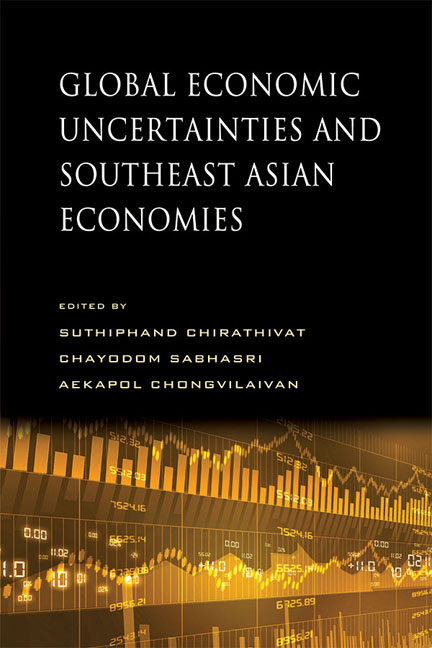Book contents
- Frontmatter
- Contents
- Preface
- Contributors
- 1 Challenges Facing a Globally Connected ASEAN
- 2 Fragile Balance of Payment in Indonesia under Global Economic Uncertainties
- 3 Malaysia in the Midst of Global Economic Uncertainties
- 4 Singapore: Reinventing Itself amid Global Economic Uncertainties
- 5 Thailand: Dependency or Diversification?
- 6 Vietnam's Economic Experience since WTO Accession
- 7 Global Economic Imbalances and Reform Policy: Evidence from Asian Economies
- 8 Foreign Exchange Rate Adjustment Policies in Asia
- 9 Monetary and Financial Architectures for ASEAN+
- 10 Global Uncertainties: Implications for the ASEAN Community
- Index
6 - Vietnam's Economic Experience since WTO Accession
Published online by Cambridge University Press: 22 July 2017
- Frontmatter
- Contents
- Preface
- Contributors
- 1 Challenges Facing a Globally Connected ASEAN
- 2 Fragile Balance of Payment in Indonesia under Global Economic Uncertainties
- 3 Malaysia in the Midst of Global Economic Uncertainties
- 4 Singapore: Reinventing Itself amid Global Economic Uncertainties
- 5 Thailand: Dependency or Diversification?
- 6 Vietnam's Economic Experience since WTO Accession
- 7 Global Economic Imbalances and Reform Policy: Evidence from Asian Economies
- 8 Foreign Exchange Rate Adjustment Policies in Asia
- 9 Monetary and Financial Architectures for ASEAN+
- 10 Global Uncertainties: Implications for the ASEAN Community
- Index
Summary
INTRODUCTION
The past six years have been a memorable experience for Vietnam. After a long period of continuous high growth and macroeconomic stability till 2007, Vietnam pitched itself to foreign investors as one of the most attractive investment destinations. The accession to the World Trade Organization (WTO) further consolidated optimism about Vietnam's growth prospects. However, after a short period of overly optimistic expectations in the first half of 2007, Vietnam had to start worrying about the overall economic situation. The accumulated inflationary pressures from continuous credit and public investment expansions, in combination with external shocks such as rising energy and rice prices, and inappropriate policy responses to a surge in capital inflows in 2007, sent the country into macroeconomic turbulence and saw it struggle to formulate a proper stabilization policy. A policy package to deal with macroeconomic instability has been implemented since March 2008. And whilst the macroeconomic situation somewhat improved by the end of 2008, the country suffered serious adverse impacts from the global financial crisis and recession. The policy stance then had to be reverted to prevent an economic downturn, via coordinated stimulus measures. Economic growth subsequently recovered but was accompanied by increasing macroeconomic instability. The situation necessitated a further switch in macroeconomic policies towards curbing inflation and restoring macroeconomic stability, which has been a dominant policy trend since early 2011.
This chapter will look into Vietnam's key experiences with macroeconomic policy management since the WTO accession in 2007. In doing so, the chapter portrays the main patterns of macroeconomic performance and related policy responses. The key focus is on the three sub-periods of macroeconomic instability or economic downturn that forced Vietnam to switch the policy stance. This will be the basis to determine the key lessons of policy management since 2007.
The remainder of the chapter is structured as follows: Section 2 provides an overview of Vietnam's macroeconomic performance and policy changes since the WTO accession in 2007. Section 3 analyses the issue of macroeconomic instability and the policy responses implemented in late 2007 to 2008. Section 4 focuses on the economic downturn and stimulus package implemented in Vietnam in late 2008 to 2009. Section 5 then summarizes the key policy responses by the Government of Vietnam to macroeconomic instability and structural problems since 2011. Finally, Section 6 draws out some key lessons from Vietnam's experience with macroeconomic stabilization since 2007.
- Type
- Chapter
- Information
- Global Economic Uncertainties and Southeast Asian Economies , pp. 123 - 147Publisher: ISEAS–Yusof Ishak InstitutePrint publication year: 2015



